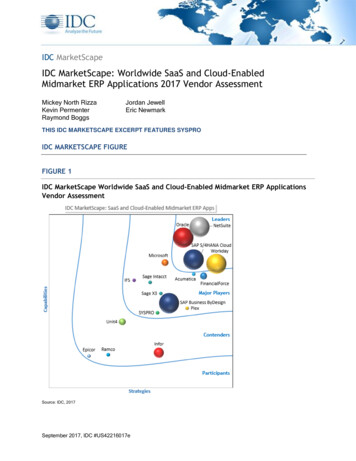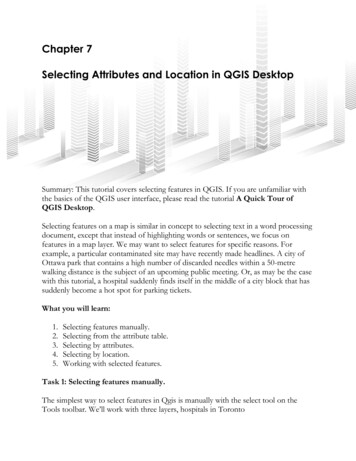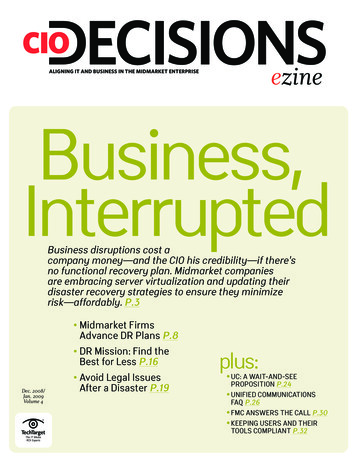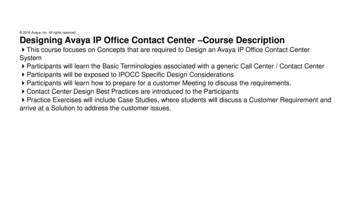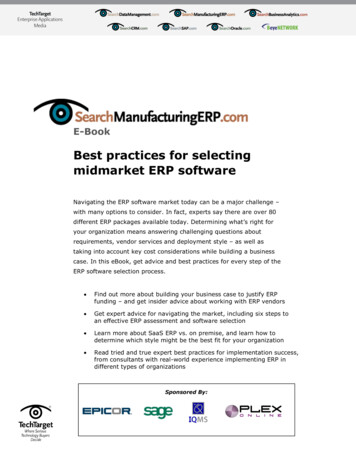
Transcription
E-BookBest practices for selectingmidmarket ERP softwareNavigating the ERP software market today can be a major challenge –with many options to consider. In fact, experts say there are over 80different ERP packages available today. Determining what’s right foryour organization means answering challenging questions aboutrequirements, vendor services and deployment style – as well astaking into account key cost considerations while building a businesscase. In this eBook, get advice and best practices for every step of theERP software selection process.Find out more about building your business case to justify ERPfunding – and get insider advice about working with ERP vendorsGet expert advice for navigating the market, including six steps toan effective ERP assessment and software selectionLearn more about SaaS ERP vs. on premise, and learn how todetermine which style might be the best fit for your organizationRead tried and true expert best practices for implementation success,from consultants with real-world experience implementing ERP indifferent types of organizationsSponsored By:
SearchManufacturingERP.com E-BookBest practices for selecting midmarket ERP softwareE-BookBest practices for selectingmidmarket ERP softwareTable of ContentsHow to build a business case for ERP in today's economyExpert advice for the ERP software selection processSaaS ERP vs. on-premise ERP software: Six key differentiatorsSeven ERP software implementation success factorsResources from our sponsorsPage 2 of 19
SearchManufacturingERP.com E-BookBest practices for selecting midmarket ERP softwareHow to build a business case for ERP in today'seconomyBy SearchManufacturingERP.com Editorial StaffThe following interview on the subject of how to build a business case for ERP in today'seconomy took place between Ray Wang, Partner for Enterprise Strategy at Altimeter Group,and Brenda Cole, assistant site editor of com: With the economy the way it is, the last thing mostcompanies want to do is put money into unnecessary new software. Before any decisionsare made, what questions should be asked to determine whether ERP is really the rightmove for your company?Wang: Everything begins with the right business drivers. If you think about when you're intight economic times, the focus should be on building business cases, allowing operationalefficiency or meeting regulatory compliance. Now that sounds simple in concept, so let's putsomething into use. For example, if you can identify a commoditized process from aninundative process, you're actually in a good position. Now what's a commoditized process?That's something that can be repeated, automated, something that isn't adding muchdifferentiation or value in your business.Once you do that, you can do things like apply technology strategies such as ERP, put thatinto a shared service, tie that back in with an upgrade strategy, consolidate instances ifyou've got different versions and think about helping consolidation and even environmentalsustainability. After that, you've got a business case in place where you can not only buildupfront savings but ongoing savings, and then you can think about which is the right vendorto work with to achieve those savings.SearchManufacturingERP.com: What about the Software as a Service option? How doyou decide between implementing an in-house ERP system and using SaaS?Wang: SaaS plays a significant role. For companies with existing ERP implementations, weexpect hybrid deployment options like SaaS to provide purpose-built solutions orPage 3 of 19
SearchManufacturingERP.com E-BookBest practices for selecting midmarket ERP softwareinnovations where many ERP vendors cannot or have not made adequate investments.You're not going to rip out your financials systems or some of your other coremanufacturing systems for a SaaS option, but you want innovation. How are you going tobring that into your staid ERP environment? Well, some examples include functionality suchas projects or project-based solutions, incentive compensation, talent management, erecruitment and donor management.In many of our studies, we show that over a 10-year period SaaS vs. on-premise makessense for smaller enterprises -- those with 50 users, 100 users, even up to 250 users. Onceyou get past 500 users, it's more of a lifestyle decision for larger enterprises; you do breakeven, but you have to trade off some things. For example, SaaS makes sense because ofthe pricing model and rapid implementation, but for clients who require heavyimplementation, support for high-volume transaction models or data security location issues-- the data can't leave the state or country or needs to be in a certain location -- this maynot be the right option. You've got to balance the business requirements with what youwant to achieve with SaaS.SearchManufacturingERP.com: Open source software is growing in popularity. Whenwould using an open source ERP package make sense?Wang: There have been a lot of improvements in open source. There are some vendorsthat have done a good job in building ecosystems. Primarily, the source code is free; that'swhat makes open source attractive. The value of these vendors comes from their ability toprovide support, maintenance and extensions. If you've got the technical know-how to selfdeploy and you find the right support groups or capabilities to be adequate, then this is arealistic option.We're seeing transaction across a variety of industries, from large public sectorenvironments and academia to manufacturing and service-based industries. The trick is tothink about your ability to self-support and the appetite you have for a scenario where youhave no one to blame for the code other than what's in open source. Open source isn't thatscary, quite frankly. I'm using a blog that's open source delivered and many companies areusing open source products such as Linux. I think open source ERP is an evolving area andone of great interest, especially given the current economic environment.Page 4 of 19
SearchManufacturingERP.com E-BookBest practices for selecting midmarket ERP softwareSearchManufacturingERP.com: What about companies that installed ERP years ago, butare considering an upgrade? Would it be more cost-effective to install a whole new system,or should businesses consider refurbishing an old ERP system?Wang: We get this question quite often. Once you factor cost, benefits, flexibility and risk - basically what we're calling the total economic impact of an upgrade -- if you takecustomers with heavy customization or integration to legacy systems, it's typically going tobe cheaper to redeploy than to upgrade. The key is to evaluate the business processes thatneed to be supported and tie those back to the user roles. Are you able to achieve yourbusiness objectives with ease? If not, then you should start from scratch. If you can andyou can keep what you have, then definitely consider the upgrade. Think about what areasyou need to upgrade. There are four types of upgrades you may need to consider. Some aretechnical upgrades, while others are something that's much simpler, involving patches orareas that you want to move in modules. Some are complete system upgrades and othersare just complete replacements.SearchManufacturingERP.com: Let's talk about contract negotiations. What should betaken into consideration while negotiating a contract with a vendor? How long do softwarecontracts generally last?Wang: First of all, the license in most cases is perpetual. The contracts typical coversupport and maintenance and last for three to four years, depending on the vendor. Keyconsiderations are business drivers, technology adoption strategy or how quickly you'regoing to adopt the product and budget. The first step is to make sure you don't over-licensefor software you don't need. This concept called shelfware -- software bought but notdeployed -- is really expensive, because you pay maintenance regardless ofimplementation. If you get a great deal on 1,000 or 10,000 licenses of software and youonly deploy a third of that license, what you end of doing is paying for maintenance and, at20-25% of the net license cost, it's the equivalent of buying new software every four or fiveyears. It's very important to make sure you sign the licenses correctly upfront. The othersareas where you should focus follow what we call the software ownership lifecycle. Thisincludes selection, implementation, utilization, maintenance and retirement of software.Page 5 of 19
SearchManufacturingERP.com E-BookBest practices for selecting midmarket ERP softwareSearchManufacturingERP.com: Usability is a hot topic these days. How have ERPvendors improved the user experience of their products in recent years? Do you thinkusability plays a part in an ERP system's ROI?Wang: Most definitely. This is an area that's been quite exciting in the last two to threeyears. We've seen some massive improvements in user experience and usability, and whatthis does is lower training costs, improves productivity and provides business flexibility. Weare seeing a significant movement to improve usability to meet enterprise principles such asa richer user experience -- role-based scenarios across barriers, usability paradigms -- sowhether it's desktop, mobility, kiosk or device, we're seeing those experiences carry over.We're also seeing business process orientation. This is support for end-to-end businessprocesses across these usability paradigms, and in some cases they're tying training tosome of these business processes so you can do real-time training while people learn on thejob. Third is configurable change: designing with flexible models and rules instead ofcustomizations. This means the business person can make a change; you don't need adeveloper to come in and configure something that can be done at a process or meta level.Fourth is actionable insight. While upgrading, we're seeing a lot of incorporation of keyinformation to roles so people can make decisions at the lowest level and in the context ofbusiness processes and the user's role. Fifth of all is collaboration. We're looking at howpeople provide secure, private interactions and open and innovative connections withstakeholders.Then there's intelligence response. In terms of usability, it's responding to contextualmodels and business events and the ability to pool information in areas that make senseand set thresholds. The last piece that's important is hybrid deployment, which means beingable to support different models of delivering that software, whether it's on-premise,hosted, instance virtualization, multi-tenant SaaS or even cloud-based business processoutsources. If you check out my blog at http://blog.softwareinsider.org, you can seehighlights from various vendors. We've captured some of the elements of this new userinterface (UI), which is really powerful with many great paradigms and definitely animprovement in terms of what we've seen in terms of boring, staid ERP UI and userexperiences in the past.Page 6 of 19
SearchManufacturingERP.com E-BookBest practices for selecting midmarket ERP softwareSearchManufacturingERP.com: We hear stories about ERP implementations runninghorribly over schedule and over budget. Is there a way to guarantee that won't happen toyour deployment?Wang: There's a three-legged stool required for success. First, clients need to be realisticabout their business requirements and they've got to keep within scope -- they can't keepchanging the requirements. Secondly, the vendor needs to honest about what is supportedout of the box. You've got to have a good discussion and think about the demo scenariosthat are "vanilla." And third, the systems integrators need to guide the clients to make themost cost-effective decisions and keep them in scope. All three are to be commended forsuccess and blamed for failure.So when you see these large ERP projects -- " 50 million wasted," or "50% of all ERPprojects fail" -- a lot of it comes back to making sure you have good design and youunderstand the objectives. What I say is, begin with the end in mind. What do people want?Think about the reports that are important and tie them back to those business processes.Make sure that they fall back to the right users, so that the data is captured correctly thefirst time and you design the product to be used correctly. This is really about access toinformation and being able to make informed decisions or automated transactions, whichmeans reducing the steps in a business process.SearchManufacturingERP.com: Can you offer any tips for saving money during the ERPselection process?Wang: This is an area we've spent a lot of time with; during my time at Forrester, I musthave done a thousand of these kinds of spender selection and contract negotiations. Theykey thing is to engage with more than two vendors and focus the selection on businessprocesses and use case demos. Unless you're a public sector entity, throw out the requestfor proposal (RFP); it's actually not very useful. We don't know many vendors who comeback and say "Oh yeah, we don't do that." The fact is everybody claims to do something.Not that they're lying, but it's either in future plans or future products.The best thing to do is to set realistic expectations with the vendors and the internalselection team. Get these demos going and see what's possible with the software. WorkPage 7 of 19
SearchManufacturingERP.com E-BookBest practices for selecting midmarket ERP softwarewith a third-party advisor who's got the main expertise and can guide you on bothtechnology adoption and contract strategy. That way, you can reduce the time it takes to dothese vendor selections. We've seen things done as quickly as a month, where people builduse case scenarios, they bring the team in for demos, they run through the rigors of thedemo and they really go out and build something. This is all part of building a businesscase.About the expert: Ray Wang is the author of the enterprise software blog "A SoftwareInsider's Point of View". The blog focuses on enterprise apps strategy, vendor selection,software contract negotiations, and emerging business and technology trends. As anenterprise strategist, Ray focuses on bridging the gap between today's enterprise landscapewith an emerging class of enterprise business solutions adopting the spirit of socialtechnologies and Enterprise 2.0 concepts. Research topics often include ERP, CRM, projectbased solutions, order management, master data management (MDM) and Software as aService (SaaS).Page 8 of 19
SearchManufacturingERP.com E-BookBest practices for selecting midmarket ERP softwareExpert advice for the ERP software selectionprocessBy Panorama Consulting Group, SearchManufacturingERP.com Expert ContributorsMost companies that are evaluating potential ERP solutions confine themselves to tier Ivendors. If you have a small to midsized business, there are countless other options. For alarge company, there are dozens of viable options that can deal with complex businessesand scale for growth.Here at Panorama Consulting Group, we encourage our clients to go through the ERPselection process with their "eyes wide open." When our company embarks on a softwareselection project with clients, we start with more than 80 different ERP packages. Most areofferings from established companies with established client bases. Many can deal withcomplex requirements, such as product configuration, product development management,engineering change orders, project accounting, etc. The only difference is that they don'treceive the publicity and marketing exposure that the larger guys have. Based on ourexperience, they are often a better fit, more flexible, and less risky than typical tier Isoftware options.There are plenty of viable alternatives to the household ERP names. Many of thesecompanies are well established, with international offices, international customers, and usercounts ranging from 10 to 1,000s. And many of their offerings will cost much less topurchase and implement than a tier I option.In addition, these smaller vendors often provide more functional specialization and industryfocus than traditional ERP options. A complex, engineer-to-order type of discretemanufacturer is not likely to want a package that also tries to deal with the processes forhigh-volume, make-to-stock manufacturing. Instead, you should consider a solution thathandles your type of business very well rather than one that tries to be "all things to allpeople."Page 9 of 19
SearchManufacturingERP.com E-BookBest practices for selecting midmarket ERP softwareSaaS ERP vs. on-premise ERP software: Six keydifferentiatorsBy Panorama Consulting Group, SearchManufacturingERP.com Expert ContributorsIn uncertain economic conditions, we believe that companies will redefine the meaning ofERP and how they plan to deploy it. Today, the terms "Software as a Service" and "ondemand" describe software functionality as delivered over the Internet from a singleapplication instance that is shared across all users. Software as a Service (SaaS) and opensource are likely to appeal to some companies as potential lower-cost and lower-riskalternatives to traditional ERP. However, there are risks that need to be considered alongwith these two types of ERP offeringsThe beauty of modern ERP packages is that you have options to choose from during yourERP software selection. You can either deploy a solution by hosting it internally on your ownservers (traditional ERP), or if you would rather not deal with the software, you can have ithosted somewhere else (SaaS). In the process of ERP selection, though, you should beaware of six key variables that will ultimately factor into the decision that is right for you:1. Simplicity. In general, SaaS is simpler to deploy from a technical perspective. Becauseyou don't need to purchase additional servers or physically install the software yourself -you can simply get started with a basic Internet connection -- it can be an easy and quickmeans of deploying the software. On the other hand, the high level of technical ease maycreate additional business complexities that you may not otherwise experience withtraditional ERP (see #2 below).2. Flexibility. Because traditional ERP is installed on your servers and you actually own thesoftware, you can do with it as you please. You may decide to customize it, integrate it toother software, etc. Although any ERP software will allow you to configure and set up thesoftware as you like, SaaS is generally less flexible than traditional ERP in that you can'tcompletely customize or rewrite the software. Besides, SaaS vendors are more likely toprovide only one version, whether you need the upgrade functions or not, and since thesoftware is delivered over the Web, you have no choice but to accept them. Conversely,Page 10 of 19
SearchManufacturingERP.com E-BookBest practices for selecting midmarket ERP softwaresince SaaS can't be customized, it reduces some of the technical difficulties associated withchanging the software.3. Control. Because of #2 above, many companies find that they don't have control overSaaS software as they would like, relative to traditional ERP. This is especially true ofmidsized or large companies with well-defined business processes that cannot be changedto fit the software. Small companies can generally adapt their business processes to thesoftware more easily than large organizations can. Besides, SaaS effectively createsconstraints on supplying complex functionality.4. Accessibility. SaaS uses the Internet to access systems once deployed and maintainedoff-premises. Since SaaS is entirely accessed through the Web, you are in "a world of hurt"if the Internet goes down. Alternatively, traditional ERP does not require Internet reliability,provided your users are accessing the software from inside your company's network.5. Cost. In general, SaaS can be deployed at a much lower initial cost and lower total costof ownership; companies can avoid costly licenses, complex hardware, softwareinfrastructure and no technology maintain needed. This type of cost-effectiveness can beattractive to smaller businesses, but the ongoing annual payment or monthly fees can behigher for SaaS because you're paying to use the software on a subscription basis. Muchlike leasing vs. buying a car, your payment never goes away as long as you're using thesoftware. It can become costly as you grow and add employees to the system.6. Integration. Companies that have implemented traditional ERP typically haveapplications that run on the same platform. They have avoided tough integration issues andimproved visibility into operations. Integration is a major issue for SaaS companies, whichneed to provide on-premise integration for their customers to integrate cloud applicationswith existing legacy applications. A company with SaaS will be left trying to integrate hostedsoftware from a variety of vendors using middleware from yet another vendor.At a time when industries and economies are decreasing their growth forecasts into singledigits, IDC has predicted that SaaS growth will be more than 40% in the current year. SaaSoffers "right-sized, zero-capex alternatives to on-premise applications" and easy-to-usesubscription services, which are attractive points to companies. This is true especially in thisPage 11 of 19
SearchManufacturingERP.com E-BookBest practices for selecting midmarket ERP softwareharsh economy. Clearly, there are tradeoffs between the two options. These six factorsshould be thoroughly evaluated as part of any effective ERP software selection project.Page 12 of 19
SearchManufacturingERP.com E-BookBest practices for selecting midmarket ERP softwareSeven ERP software implementation successfactorsBy Panorama Consulting Group, SearchManufacturingERP.com Expert ContributorsChoosing the right software is the most important consideration in any ERP project. Acompany that chooses software that's not a good fit for its business or requires significantcustomization to support key requirements is more likely to overshoot its implementationbudget. A diligent ERP software selection process minimizes the risk of choosing a solutionthat is a bad match for your situation.Simply asking "yes" or "no" questions about software functionality, as is common in manyRFPs, can be misleading. Different packages handle certain functionality with varyingdegrees of success. Companies should define business requirements as part of their ERPsoftware selection process – and would be well-advised to define their desired businessprocesses so evaluation teams can consider potential ERP software packages in the contextof company workflows.The world of ERP is tainted by horror stories of projects gone wrong. Companies such asShane Co. have had widely publicized complaints about ERP software vendors because of afailed implementation. In some extreme cases, these companies sue because they couldn'tship product or their entire business shut down because the software did not work correctly.So how does one increase the likelihood of ERP success and the realization of ERP benefits?Many manufacturers assume that the ERP software they purchase determines projectsuccess or failure. In reality, 95% of a project's success or failure is in the hands of thecompany or team implementing the software, not the software vendor.Here are the seven ERP implementation critical success factors that we have seen:1. Focus first on business processes and requirements. Too often, companies get tiedup in the technical capabilities or platforms that a particular software application supports.None of this really matters. What does matter is how you want your business operations toPage 13 of 19
SearchManufacturingERP.com E-BookBest practices for selecting midmarket ERP softwarerun and what your key business requirements are. Once you have this defined, you canmore easily choose the software that fits your unique business needs.2. Focus on achieving a healthy ERP ROI (return on investment), including postimplementation performance measurement. This requires doing more than justdeveloping a high-level business case to get approval from upper management or yourboard of directors. It also entails establishing key performance measures, setting baselinesand targets for those measures, and tracking performance after go-live. This is the only wayto truly realize the benefit potential of ERP.3. Strong project management and resource commitment. At the end of the day, yourcompany owns the success or failure of a large ERP project, so you should manage itaccordingly. Ensure that you have a strong project manager and your "A-players" from thebusiness to support and participate in the project.4. Commitment from company executives. Any project without support from its topmanagement will fail. Support from a CIO or IT director is not enough. No matter how wellrun a project is, problems arise (such as conflicting business needs), so the CEO and yourentire C-level staff needs to be on board to deal with some of these.5. Plan up front. An ERP vendor's motive is to close a deal as soon as possible. Yoursshould be to make sure it gets done right. Too many companies jump into a project withoutvalidating the software vendor's understanding of business requirements or its project plan.The more time you spend ensuring that these things are done right at the beginning of theproject, the less time you'll spend fixing problems later on.6. Ensure adequate training and change management. ERP systems involve bigchange for people, and the system will not do you any good if people do not understandhow to use it effectively. Spending time and money on training, change management andjob design is crucial to any ERP project.7. Make sure you understand why you're implementing ERP. This may be the mostimportant one. It's easy to see that many big companies are running SAP or Oracle andmaybe you should too, but it's harder to consider that maybe you don't need an ERP systemPage 14 of 19
SearchManufacturingERP.com E-BookBest practices for selecting midmarket ERP softwareat all. Perhaps process improvement, organizational redesign or targeted best-of-breedtechnology will meet your business objectives at a lower cost. By understanding yourbusiness objectives and what you're trying to accomplish with an ERP system, you will beable to make a more appropriate decision on which route to take. . .which may or may notinvolve ERP.It is important to understand exactly what you are as an organization now and what youwant to be in the future. This includes understanding your strengths, weaknesses and corecompetencies, as well as the areas you want to improve. Making these decisions in themidst of an ERP implementation can be a rushed process, and making key strategicdecisions like these in a sloppy fashion will create significant confusion down the road.The key takeaway is this: ERP cannot be implemented successfully without clearrequirements, which are critical to ERP success. By the same token, clear requirementscannot be defined until business processes are well-defined. And business processes cannotbe defined until organizations establish a clear strategic direction. Organizations must takethese areas into consideration during their ERP assessment and software selectionprocesses.Page 15 of 19
SearchManufacturingERP.com E-BookBest practices for selecting midmarket ERP softwareResources from EpicorFive Ways ERP Can Help You Implement Lean2010 Aberdeen ERP in Manufacturing ReportEpicor ERP Virtual TourAbout EpicorEpicor Software is a global leader delivering business software solutions to themanufacturing, distribution, retail, hospitality and services industries. With 20,000customers in over 150 countries, Epicor provides integrated enterprise resource planning(ERP), customer relationship management (CRM), supply chain management (SCM) andenterprise retail software solutions that enable companies to drive increased efficiency andimprove profitability. Founded in 1984, Epicor takes pride in more than 25 years oftechnology innovation delivering business solutions that provide the scalability and flexibilitybusinesses need to build competitive advantage. Epicor provides a comprehensive range ofservices with a single point of accountability that promotes rapid return on investment andlow total cost of ownership, whether operating business on a local, regional or global scale.Page 16 of 19
SearchManufacturingERP.com E-BookBest practices for selecting midmarket ERP softwareResources from IQMSShort-Run Manufacturer Builds Long-term Success with EnterpriseIQERP In A Recovering Economy: Now is the perfect time to invest!Leading Automotive Supplier Accelerates Lean Operations with EnterpriseIQAbout IQMSIQMS offers the innovative EnterpriseIQ ERP software for the manufacturing industry.Designed as a scalable, single source solution with multiple location, language and currencycapabilities, EnterpriseIQ is the best industry specific solution available.Page 17 of 19
SearchManufacturingERP.com E-BookBest practices for selecting midmarket ERP softwareResources from SageDiscover Sage ERP X3Accelerate Your Business ExchangesExperience a Rapid ROIAbout SageTrust a leader - Sage is the number one worldwide provider of accounting and ERP solutionsfor small and midsized businesses. We support more than 3.1 million customers in the U.S.and Canada, and over 6.1 million customers worldwide. Traditionally, we have beenassociated with financial management software, but over the last 25 years we have takenthis experience and applied it to other areas. Today, we are the third largest provider of ERPsolutions worldwide for companies regardless of size. Our ERP solutions help businesses andorganizations manage processes across all functio
midmarket ERP software Navigating the ERP software market today can be a major challenge - with many options to consider. In fact, experts say there are over 80 . funding - and get insider advice about working with ERP vendors Get expert advice for navigating the market, including six steps to

